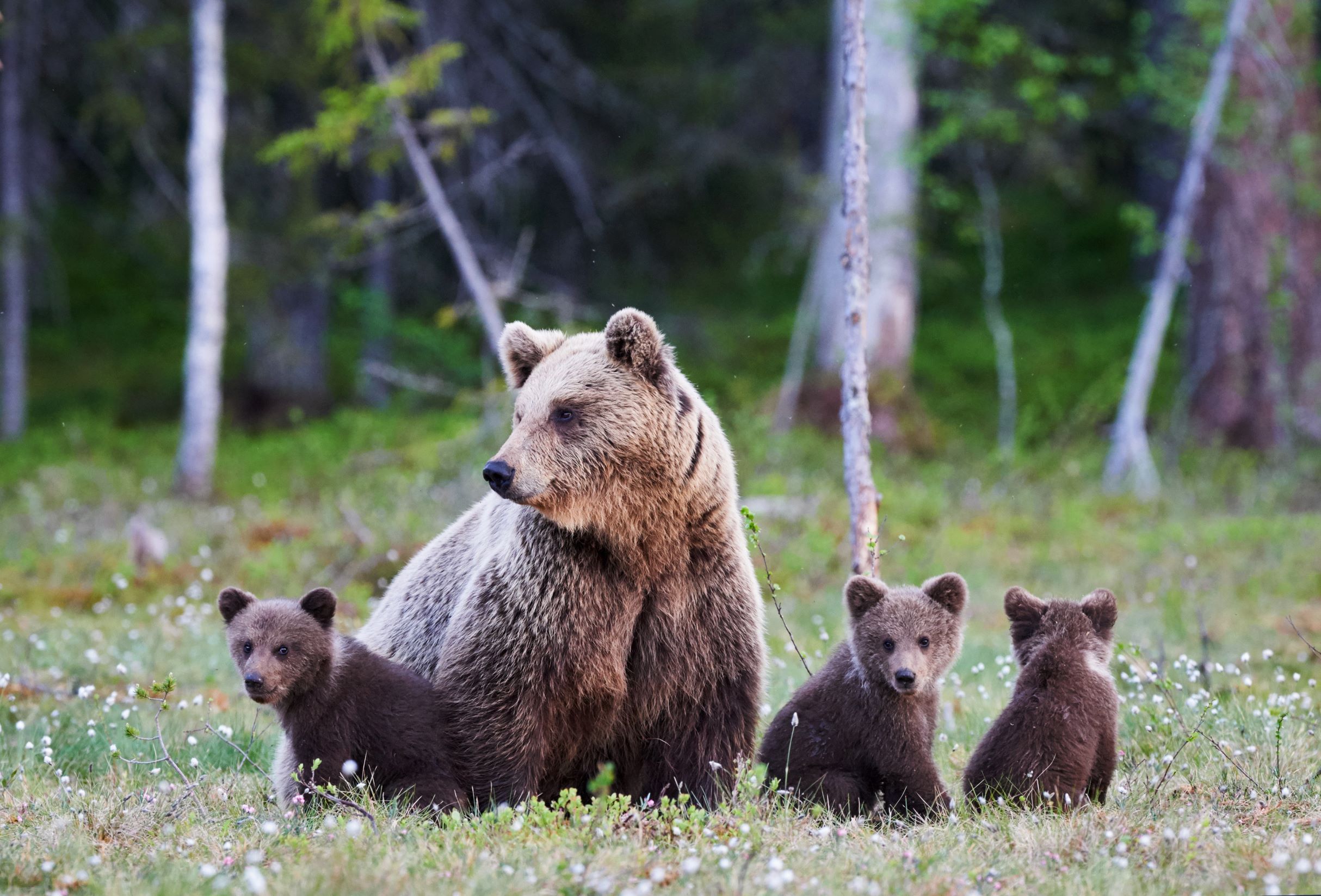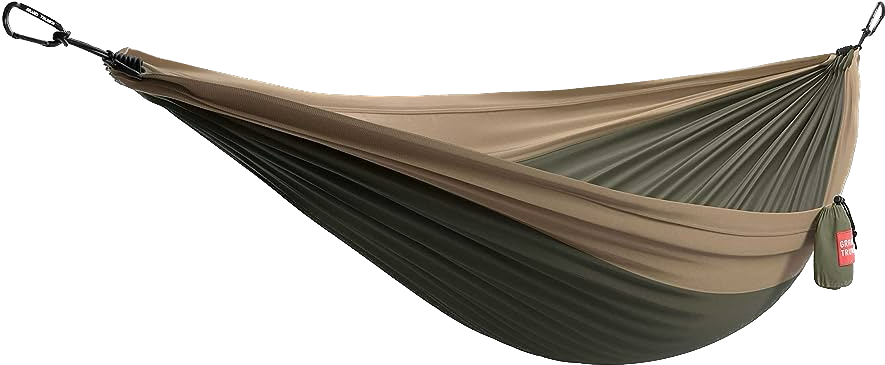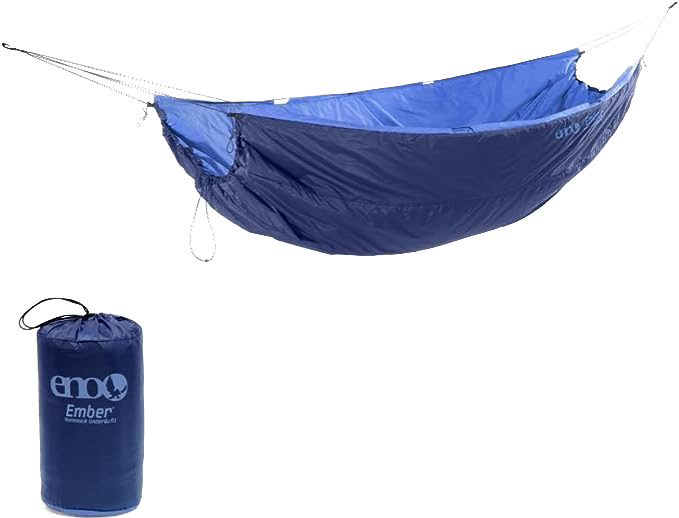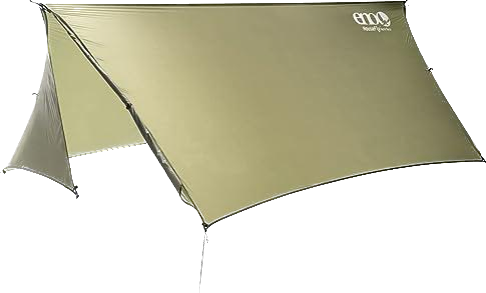There are many reasons why I personally love hammock camping. It’s a unique and fun way to take in nature and get away from the world. Nothing is quite as relaxing as being suspended between trees, and enveloped by the peaceful sounds of the great outdoors.
Although this experience can be incredibly rewarding, being in a hammock presents a different level of exposure than traditional camping in a tent or camper. Because of your exposure in a hammock, you should take extra consideration of the risks associated with wild animals that roam the same outdoor landscapes.
This brings up a question I had when I first started hammocking camping and one common among outdoor enthusiasts- Is hammock camping safe from animals?
Hammock camping is generally safe from animals. By elevating yourself off the ground, you reduce the chances of encountering wildlife. Additionally, choosing campsites away from animal habitats, storing food in a bear box, and using a bug net will help ensure your safety hammocking.
Understanding the Risks: Animals and Hammock Camping

I know first-hand how calming and relaxing hammock camping can be. However, it’s important to remember that we are sharing the wilderness with a variety of wild animals. These can range from larger animals like bears, raccoons, and snakes to smaller insects and arachnids such as ticks, mosquitoes, and spiders. Sometimes we forget about these creatures but they can pose risks to you on your camping trip, so it’s important to be mindful of each.
So, how can we safely hammock camp while coexisting with these native creatures? The key is understanding your local wildlife area and making a minimal impact on their environment. If you’re curious to know if hammock or tent camping is safer, check out our article on the pros and cons of hammock vs tent camping.
In the following sections, we’ll dive deeper into the risks posed by various animals and provide practical tips for staying safe during your hammock camping adventure.
Safely Avoid Bears and Other Animals While Hammock Camping
Animals such as bears, raccoons, and coyotes can be both a source of awe and a potential threat to hammock campers. These animals are naturally curious and may be drawn to your campsite if proper precautions are not taken. Encountering a large mammal like a bear can be dangerous, while smaller animals like raccoons and coyotes can be a nuisance, potentially damaging your gear or stealing your food.
To stay safe from these creatures take the following steps:
- Avoiding areas with obvious signs of animal activity
- Maintaining a safe distance from food sources
- Set up your hammock in a secure location
- Store food in a bear-proof bag or other secure areas away from your hammock
We cover these steps and more in our deep dive article, “Will Bears Bother You In a Hammock?“. By taking these steps, you’ll be better prepared to enjoy your hammock camping experience without any unwelcome surprises.
Additionally, you can check out these safety tips for NJ Department of Environmental Protection for bear safety.
Some people like to bring their pets and dogs on hammock camping trips. They’re a great companion to have and also be aware of other animals around you and help you be safe. If you decide to bring your dog, check out the article we wrote that will give you tips on how to hammock camp with your dog.
Keeping Insects and Arachnids Away from Your Hammock: Ticks, Mosquitoes, and Spiders
Insects and arachnids, while generally smaller and less intimidating than mammals, can still cause discomfort and illness during your hammock camping trip. Ticks, mosquitoes, and spiders are among the most common pests you might encounter, and it’s crucial to protect yourself against their bites and stings.
Ticks can transmit diseases such as Lyme disease, Rocky Mountain spotted fever, and ehrlichiosis, while mosquitoes can carry West Nile virus, malaria, and Zika virus. Spiders, on the other hand, can cause allergic reactions or even be venomous in some cases.
I know mosquitoes can be a nuisance while outdoors, so we’ve created a complete guide on how to Hammock without Mosquitoes. You should check out that full list of tips if you’re having problems with mosquitoes while hammocking. In the meantime, try t these tips to minimize the impact of insects and arachnids:
- Use a bug net
- Apply insect repellent
- Wear proper clothing to keep these pests at bay
- Light citronella candles
Keeping Snakes and Reptiles Out of Your Hammock Area
While less common, snakes and reptiles can also pose a danger to hammock campers. In certain regions, venomous snakes like rattlesnakes, copperheads, water moccasins, and coral snakes may be present, while large reptiles like alligators or crocodiles can inhabit some areas.
As you set up your camp, pay attention to areas where snakes could hang out or be. For a comprehensive guide check out our article “How to Avoid Snakes While Hammocking“. This article will tell you everything you need to know if you have snakes in your camping destination. By familiarizing yourself with the local wildlife and their habitats, you can make informed decisions about where to set up camp and how to minimize the risk of encountering these potentially dangerous animals.
Take the following steps to best protect yourself from snake and reptile encounters:
- Hang up shoes and gear if possible
- Check gear and shoes before putting them on
- Avoiding hanging your hammock under large branches
- Check for signs of snake or reptile activity
I also recommend avoiding hammock camping in forested or rocky terrains, storing food securely, maintaining a neat campsite, and inspecting your hammock or bags for any openings where a snake may enter.
How to Select the Right Campsite for Your Hammock

Let’s talk about selecting a good campsite for hammocking camping. A well-selected campsite can help minimize the likelihood of animal encounters and provide a comfortable and safe camping area for your outdoor getaway.
In the following sections, we’ll explore the importance of assessing animal signs, maintaining a safe distance from food sources, and considering terrain when selecting the perfect campsite.
For More in-depth information check out: Is It Safe to Sleep in a Hammock Camping?
Assessing Animal Signs
Before setting up camp you should scan the area for any signs of animal activity. Indications of animal presence can include tracks, scat, trails, rubs, scratches on trees, and disturbed vegetation.
Some signs are more crucial than others. For example, you may be fine if you find a game trail or tracks of small animals. Simply set up camp a good distance away where you will not be disturbed. Other signs may indicate bigger risk and danger. If you find yourself some fresh bear scat, I highly recommend finding a different area to set up your camp.
This leads to determining how recently those signs were created. Did an animal leave recent tracks? Have they set up a bed nearby the previous night? Typically animals will leave the area if they sense human activity, but I highly recommend stirring clear of anything that shows recent animal activity.
Safe Distance from Food and Water Sources
Sometimes the most majestic and beautiful spot to hammock camp is right by a river or lake. However, keep in mind these areas are often a source of food and water. Additionally, open water sources tend to be spawning hubs for bugs and mosquitoes. If you’re really dying for an epic view of the lake or river, I recommend setting up your hammock slightly more inland. This alone will cut down 90% of the issues you’ll have with both bugs and unwanted animal visitors throughout your trip.
Properly Store Food Away from Wildlife
Additionally, local wildlife may become aware of your campsite and view it as a viable source of food. Animals are naturally attracted to food and can smell it a good distance away.
When storing food, use a food bag, bear box (canister), or watertight container. For added protection, some people leave their food in their cars to protect it from animals.
Essentially you want to store food in a place where animals can’t get to it, protect it from the weather, maintain cold foods at a cold temperature, and kept away from your hammock – at least 100 yards away if you’re in bear country.
Terrain Considerations
The terrain of your chosen campsite can also play a significant role in your safety from animals during your hammock camping adventure. When selecting terrain, I recommend looking for flat surfaces, avoiding locations with dense vegetation, and steering clear of low-lying areas that could fill with water.
You never know what could be hiding in tall grass and finding a flat area will make life easier when setting up and taking down your campsite.
When looking for a good pair of trees to hang your camping hammocks from, avoid any dead trees and keep an eye out for overhanging dead branches. If the weather turns sour or if the wind picks up, a tree could blow over or a branch could break off and land on you or your hammock. Ideally, you can find two sturdy trees in a flat area without any overhanging branches.
Additional Tips for Hammock Camping Like a Pro

By being aware of potential risks, understanding the local wildlife, and implementing the guidelines discussed in this blog post, you can significantly reduce the likelihood of animal encounters and maximize your enjoyment during your hammock camping adventure.
In the following sections, we’ll explore the importance of awareness and education, noise and light precautions, and emergency preparedness in ensuring a safe and enjoyable hammock camping experience.
Awareness and Education
When it comes to being out in the great outdoors, preparation, awareness, and education are all key components of staying safe during your hammock camping trip. Before heading out, you should familiarize yourself with animals and wildlife native to the area where you plan to camp. This should include predators, scavengers insects, spiders, snakes, and reptiles.
By understanding the environment and wildlife, you should feel confident in making informed decisions about where to set up camp, how to store food, and what precautions to take to ensure your safety during your hammock camping adventure.
Use Noise and Light to Keep Animals Away
Noise and light can play a role in deterring animals from approaching your campsite. If you’re worried about animals going through your campsite, making your presence known could help keep them away. As mentioned earlier, most animals are more scared of humans than we are of them. Just having a light around signals to everyone and everything around you of your presence. For that exact reason, campfires are also great to have if you’re worried about animals. If you’re worried about larger animals, try bringing along an air horn. They’re light, easy to pack, and perfect if you need something to help scare away an animal from your campsite.
One thing to consider is protecting your hammock from wildlife while you’re away. This can range from insects or spiders falling into your hammock, or squirrels chewing your hammock and straps. Always inspect your hammock before getting in and make sure there aren’t any extra critters in your hammock and that your equipment is still sturdy and able to support your weight.
Lastly, be aware and considerate of others that are camping or enjoying the outdoors. We all like to go outside to get away from the busyness of the city. Try to minimize your impact on others by limiting your light pollution, noise, and loud music. Especially if you’re in an area with quiet hours or neighboring campsites.
Always have a Backup Plan and be Prepared for Emergencies
Sometimes things don’t go as planned and emergencies come up. Wherever you decide to go, develop an emergency plan. This can include preparing a way to contact family, friends, and emergency services – even when you don’t have cell service. Also a plan for evacuating your campsite if necessary, and ensuring your vehicle is prepared with the proper supplies.
At the bare minimum, bring an emergency first aid kit, extra water, and sunscreen, and let people know where you’re going and when you expect to be back.
Summary
Hammock camping offers a unique and relaxing way to connect with nature. By taking safety precautions, creating backup plans, and being prepared for your trip, you can minimize the likelihood of animal encounters and maximize your enjoyment during your hammock camping adventure. So, go ahead and embrace the thrill of hammock camping, knowing that you’re well-prepared to stay safe and secure among the wonders of the wild.
Frequently Asked Questions
Is hammock camping safe bears?
Yes, hammock camping in bear country can be done safely if the proper precautions are taken. Most experts recommend avoiding bright-colored sleeping quarters and planning for a high enough suspension that avoids ground scent.
Additionally, it’s important to practice bear safety principles such as proper food storage and avoidance of open sources of food.
What are the disadvantages of hammock camping?
Hammock camping can have its disadvantages. Although it may be more comfortable than tent camping for some people, those who toss and turn during the night may find it too restrictive and uncomfortable.
Additionally, without additional protection from rain, dew, or wind, hammock campers may suffer more exposure to the elements than when using a tent.
Is hammock camping safer than tent camping?
Overall, hammock camping is not necessarily safer than tent camping, and may even require additional protection to stay dry and warm. To be adequately safe and comfortable while hammock camping, you should ensure that you have the necessary gear such as a large tarp, guy lines, stakes, an underquilt or foam sleeping pad, and bug netting.
Where does your dog sleep when hammock camping?
When hammock camping, it is best to let your dog sleep in whatever way suits him or her best. While some dogs enjoy joining you in the hammock, larger breeds may find more comfort on the ground beneath your hammock, in a hammock of their own, or even in a tent.
Ultimately, letting your pup choose their sleeping spot will ensure that they’re most comfortable.



 Hello there, we're Vira Outdoors!
Hello there, we're Vira Outdoors!

